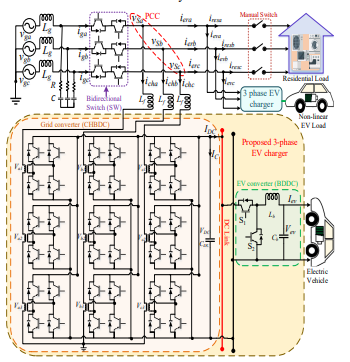A Unified Control of Grid-Interactive Off-Board EV Battery Charger with Improved Power Quality
Also Available Domains Power Quality
Objective
The main objective of this project is to design a multifunctional EV charging infrastructure with G2V, V2G, C4G, and V2L operation modes by using STF and SMC-DLVC based control algorithm.
Abstract
In this project, a self-tuning filter (STF) and sliding mode control (SMC) based control algorithm for a grid interactive off-board electric vehicle (EV) battery charger to power the EV batteries and simultaneously improve the grid power quality. In grid-connected operation (GCO), the charger uses the STF based control strategy to estimate the fundamental load current and synchronizing voltage templates to generate a pure sinusoidal reference current. Compared to phase-locked-loop (PLL) and second-order generalized integrator (SOGI), the STF based technique precisely estimates the synchronizing voltage templates during non-ideal grid voltage conditions. Therefore in GCO, the charger reference current ensures unit power factor in grid-to-vehicle/vehicle-to-grid (G2V/V2G) operation mode and harmonic free grid current in charger-for-grid (C4G) operation mode. Furthermore, the charger operates in vehicle-to-load (V2L) operation mode during grid outages to maintain an uninterrupted supply to the residential load. The control algorithm also includes a grid synchronization technique to achieve a smooth transition between GCO and V2L. Furthermore, an SMC-based DC-link voltage controller (SMC-DLVC) is proposed to reduce DC-link voltage overshoot with finite-time convergence during external disturbances in all operation modes. The simulation results can be evaluated by using Matlab/Simulink Software.
Keywords: Charger-for-grid (C4G), EV battery charger, G2V, Power quality (PQ), Sliding mode control, V2G.
NOTE: Without the concern of our team, please don't submit to the college. This Abstract varies based on student requirements.
Block Diagram

Specifications
Software Configuration:
Operating System : Windows 7/8/10
Application Software : Matlab/Simulink
Hardware Configuration:
RAM : 8 GB
Processor : I3 / I5(Mostly prefer)
Learning Outcomes
- Introduction to Matlab/Simulink
- What is EISPACK & LINPACK
- How to start with MATLAB
- About Matlab language
- About tools & libraries
- Application of Matlab/Simulink
- About Matlab desktop
- Features of Matlab/Simulink
- Basics on Matlab/Simulink
- Introduction to controllers.
- Study of PWM techniques.
- Project Development Skills:
- Problem analyzing skills
- Problem solving skills
- Creativity and imaginary skills
- Programming skills
- Deployment
- Testing skills
- Debugging skills
- Project presentation skills
- Thesis writing skills


 Paper Publishing
Paper Publishing
